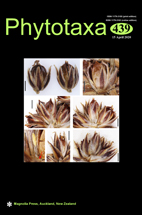Abstract
Termitomyces floccosus and T. upsilocystidiatus nov., are introduced from China and Thailand based on morphological characteristics and molecular phylogenetic analyses. Termitomyces floccosus is characterized by a squamulose pileus and stipe, and utriform cheilocystidia. Termitomyces upsilocystidiatus is characterized by Y-shaped cheilocystidia. Phylogenetic analyses of combined mrSSU and nrLSU sequence data confirmed that the two taxa are distinct Termitomyces species. Comprehensive descriptions, colour photographs and a phylogenetic tree showing the position of the two new species are provided.

